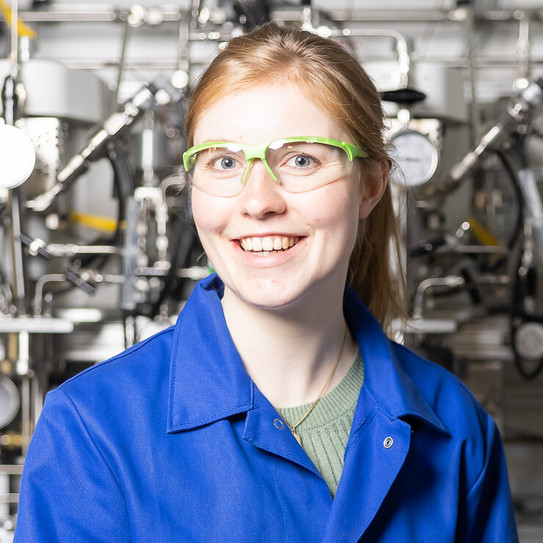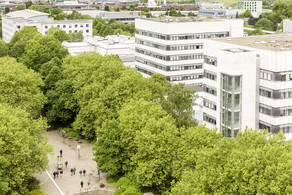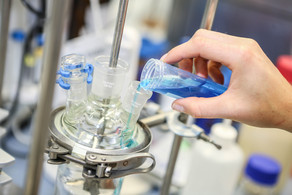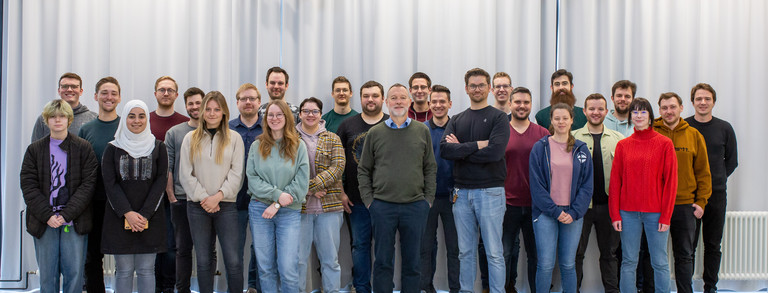M. Sc. Johanna Vondran
Contact through the Secretariat:
monika.boschtu-dortmundde

Curriculum Vitae
During her bachelor studies (2012-2015), Johanna Vondran focused on industrial chemistry and finished her thesis on the topic of the “palladium catalyzed aminocarbonylation of unsaturated substrates through formamides” under supervision of Prof. Behr at TU Dortmund. She received the “Deutschlandstipendium” first by Sparkasse Dortmund (2014/15), then by BASF (2015-2017). In advanced stage of her master studies, she went abroad to absolve an internship on flow chemical processes at the University of Melbourne, Australia, in the group of Dr. Polyzos. She graduated in the group of Prof. Vogt in September 2017 at TU Dortmund on the topic of the “palladium-catalyzed carbonylative aminetelomerization of 1,3-butadiene with secondary amines to linear unsaturated pelargonic amides”. Afterwards, she gained industrial work experience through an internship at Covestro in Leverkusen working on UV-curable prepregs. Since April 2018 she has worked as a research associate at the laboratory of industrial chemistry supported by a two-year Ph.D. scholarship by “Fonds der chemischen Industrie”.
Publications & Conferences
- Vondran, J., Benninghoff, T., Emminghaus, A.I., Seidensticker, T., (2022). "Catalytic Synthesis of Methyl 9,10-dihydroxystearate from Technical Feedstocks in Continuous Flow via Epoxidation and Hydrolysis". Eur. J. Lipid Sci. Technol. 124(7), DOI: 10.1002/ejlt.202200041 .
- Vondran, J., Seifert, A.I., Schäfer, K., Laudanski, A., Deysen, T., Wohlgemuth, K., Seidensticker, T., (2022). "Progressing the Crystal Way to Sustainability: Strategy for Developing an Integrated Recycling Process of Homogeneous Catalysts by Selective Product Crystallization". Ind. Eng. Chem. Res. 61(27), 9621–9631, DOI: 10.1021/acs.iecr.2c00476 .
- Vondran, J., Peters, M., Schnettger, A,. Sichelschmidt, C., Seidensticker, T., (2022). "From tandem to catalysis – organic solvent nanofiltration for catalyst
separation in the homogeneously W-catalyzed oxidative cleavage of renewable methyl 9,10-dihydroxystearate". Catal. Sci. Technol., DOI: 10.1039/D1CY02317A. - Gladius, A. W., Vondran, J., Ramesh, Y., Seidensticker, T., Agar, D. V. (2021). "Slug flow as tool for selectivity control in the homogeneously catalysed solvent-free epoxidation of methyl oleate". J. Flow Chem. 11, 407-427, DOI: 10.1007/s41981-021-00199-6.
- Vondran, J., Pela, J., Palczewski, D., Skiborowski, M., Seidensticker, T. (2021). "Curse and Blessing–The Role of Water in the Homogeneously Ru-Catalyzed Epoxidation of Technical Grade Methyl Oleate". ACS Sustainable Chem. Eng. 9 (34), 11469–11478, DOI: 10.1021/acssuschemeng.1c03573.
- Vogelsang, D. , Vondran, J. , Hares, K. , Schäfer, K. , Seidensticker, T. , and Vorholt, A. J. (2019). "Palladium catalysed acid‐free carboxytelomerisation of 1,3‐butadiene with alcohols accessing pelargonic acid derivatives including triglycerides under selectivity control". Adv. Synth. Catal. 362, 679–687, DOI: 10.1002/adsc.201901383.
- Vogelsang, D. , Vondran, J. , and Vorholt, A. J. (2018). "One-step palladium catalysed synthetic route to unsaturated pelargonic C9-amides directly from 1,3-butadiene". J. Catal. 365, 24–28, DOI: 10.1016/j.jcat.2018.06.004.
- Seidensticker, T. , Furst, M. R. L. , Frauenlob, R. , Vondran, J. , Paetzold, E. , Kragl, U. , and Vorholt, A. J. (2015). "Palladium-catalyzed aminocarbonylation of aliphatic alkenes with N,N-dimethylformamide as an in situ source of CO". ChemCatChem 7, 4085–4090, DOI: 10.1002/cctc.201500824.
- October 2019, Seville, Spain: 17th Euro Fed Lipid Congress and Expo, “Catalyst recycling concept for the homogeneously catalyzed oxidative cleavage of methyl oleate as renewable feedstock with hydrogen peroxide as green oxidant
- August 2019, Aachen, Germany: Europacat 2019, “Progress in homogeneously catalyzed oxidation reactions – sustainability through catalyst recycling”
- March 2019, Karlsruhe, Germany: 10th Workshop on Fats and Oils as renewable feedstock for the Chemical Industry, ”Progress in homogeneously catalyzed oxidation reactions – sustainability through catalyst recycling”
- March 2019, Weimar, Germany: DECHEMA 52. Jahrestreffen Deutscher Katalytiker: ”Progress in homogeneously catalyzed oxidation reactions – sustainability through catalyst recycling”
- December 2016, Melbourne, Australia: Europacat, 41st annual synthesis symposium, ”Aminocarbonylation of olefins with N,N-dimethylformamid (DMF) – in situ generation of CO and dimethylamine“.






